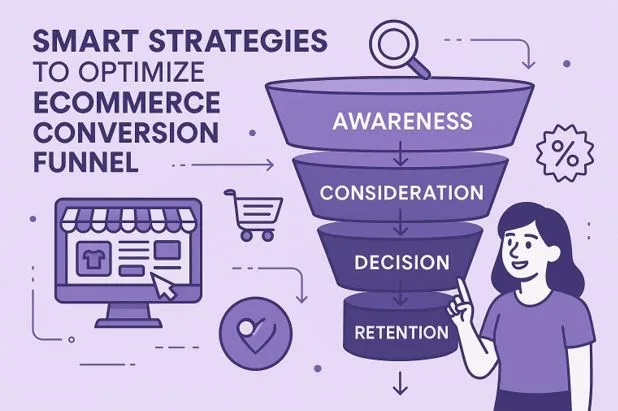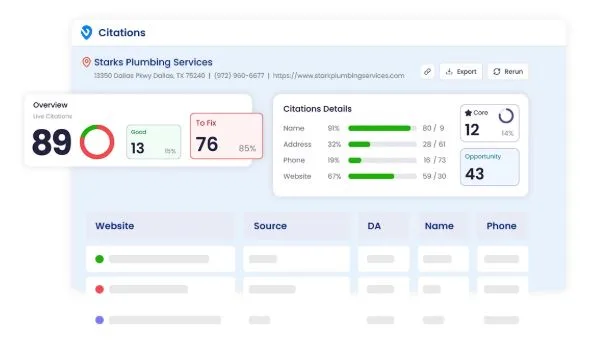Smart Strategies to Optimize Your eCommerce Conversion Funnel
Every click, scroll, and interaction on your online stores tells a story about the customers. However, not every visitor completes the story with a purchase. The gap between interest and conversion is where most businesses lose their potential chance to generate revenue. This is exactly where eCommerce conversion funnel optimization makes a greater difference.
For product managers and marketing teams, the conversion funnel is important to know about the customer movements. It is a measurable system that helps you to identify what attracts your buyers, what makes them hesitate about and what finally encourages them to purchase more. Optimizing the funnel ensures that your marketing efforts and product experience are working together and lead to more conversions while maintaining long-term customer relationships.
This article will walk you through the key funnel stages, performance metrics, and optimization techniques that can help both the product and marketing teams to turn insights into consistent results in improved sales.
What is an eCommerce Conversion Funnel?
An eCommerce conversion funnel is a visual representation of the journey of visitors who start by learning about your store and ultimately complete a purchase. You can consider a funnel as the map that highlights each stage where customers interact with your brand, product, and messages.
By keeping track of this journey, the product manager and marketing team can know exactly where the users drop off, which elements encourage them, and which strategy is leading to more conversions. For example, a visitor might land on the product page after clicking on a social media ad, add an item to the cart, but leave the cart without completing the purchase process. Understanding these paths allows you to implement the targeted solution that reduces the chances of friction and improves the overall shopping experience.
With the details on the conversion funnels, you can clearly define and optimize the process for your business that allows you to grow revenue. It enables you to make data-driven decisions that align with your business and allow you to drive more customers to complete the purchase process.
Key Stages of the Funnel and Their Purpose
Optimizing your eCommerce conversion funnel begins by understanding about each stage of the customer journey. The key stages of a marketing funnel allow you to guide the potential customer about the brand and retain the buyers.
Here is a structure view of the four key stages:
1. Awareness
With this step, you can attract more customers and introduce them to your product or services.
- Focuses on capturing the attention of customers through social media, content marketing, paid ads, or search engines.
- Highlight your value proposition clearly and immediately to customers.
- Make it simpler for your visitors to explore the production options and various offerings.
2. Consideration
Allow you to actively look for the solution to attract more customers. At this stage, users evaluate your product and decide whether it fits their needs or not.
- Use clear product descriptions, high-quality images, and customer reviews.
- Make sure that your website navigation is smooth and product pages are intuitive.
- Provide the information directly that allows you to address the question of customers.
3. Decision/Conversion
At this stage, you can convert the interest proposal into visitors who are ready to make a purchase. Your goal is to remove the friction and maintain the confidence.
- Optimize the checkout process for your website to offer simplicity and speed for checkout.
- Highlight trusted sources such as secure payment options, guarantee of the product, and clear return policies.
- Show incentives or offers to encourage customers to purchase more.
4. Retention/Loyalty
Conversion is not the last step; retaining the customer for the long-term is important. To retain, keep encouraging customers by giving recommendations.
- Engage buyers with personalized follow-ups, loyalty programs, or email campaigns.
- Collect feedback to improve the experience further.
- Encourage repeat purchase with targeted recommendations.
Prop Tip: To maintain an effective customer experience, a robust eCommerce development solution can make a better impact. This gives you support for including analytics, personalization, and smooth navigation to focus on optimizing conversion at every stage.
Why Funnel Optimization Matters for Product Managers and Marketing Teams
If you are running an eCommerce business, then it is important that the funnel optimization is being done. Optimizing the eCommerce conversion funnel is about sharing the responsibility between product managers and the marketing team. This will allow you to be sure about resonating with the right audience. Collaborating between these teams allows you to drive the measurable results and keep the communication consistent throughout the funnel.
Product Managers: Improve User Experience
Product managers are responsible for making the shopping experience effective and seamless. They focus on:
- Reducing Friction: Streamline navigation, search, and checkout processes.
- Improve Usability: Improve product pages, support easy browsing, and make it visually appealing.
- Testing and Iteration: Use A/B testing and analytics to make improvements in interactions.
- Personalization: Improve content and give custom recommendations as per the customer’s purchase behavior.
Marketing Teams: Manage Branding
The marketing team guides your customer through the funnel to ensure consistency. Their focus includes:
- Targeted Campaigns: Reach the right audience with the help of social media, email, ads, and content.
- Consistent Branding: Maintain the uniform messaging about the brand across all channels.
- Driving Engagement: Use CTAs, promotions, and relevant content to encourage actions.
- Behavior-Driven Optimization: Adjust the campaigns based on the analytics and improve the effectiveness.
Driving the Data-Backed Results with Collaboration
When the product manager and marketing team work together, they can optimize the funnel strategy and generate measurable results.
- Data-Driven Improvements: Gain insights into analytics about drop-offs and various opportunities.
- Consistent Communication: Aligned messaging and UX to reduce the chances of confusion and improve conversion rates.
- Align Priorities: Both maintain the focus on having a direct impact on user experience and revenue.
With the coordinated efforts between the product manager and marketing team smooth customer journey is being maintained in your business with higher conversions and strong returns on investments.
Core Metrics That Indicate Funnel Performance
Optimizing your eCommerce conversion funnel requires you to have a clear understanding of which metrics reflect on performance to maintain the customer journey. Tracking the right indicators helps product managers and the marketing team to identify the issues and reduce the chances of cart abandonment.
Here are some of the common metrics that you should be aware of:
Top-of-Funnel (TOFU) Metric
The top of the funnel maintains the focus on brand awareness and attracting more customers. Key metrics include:
- Traffic Volume: Measures how many users are visiting your site and which ones are from the organic searches.
- Engagement Rate: Show how visitors interact with your website blogs, products, or pages.
- Bounce Rate: Gives a signal of misalignment in the online store.
TOFU helps in understanding the efforts that are needed to target the right audience.
Middle-of-Funnel (MOFU) Metrics
The middle of the funnel focuses on engagement with the potential customer and evaluating your product reach. Important metrics are:
- Add-to-Cart Rate: Show how many visitors are showing interest in purchase.
- Cart Abandonment Rate: Know about the friction in the shopping experience.
- Click-Through Rate (CTA): A Measure of how many campaigns are generating natural leads.
MOFU metric handles the conversion gap in product pages or campaigns by addressing the move to purchase.
Bottom-of-Funnel (BOFU) Metric
The bottom of the funnel is where the user makes the purchase decision while taking the desired action. Key metrics include:
- Conversion Rate: Generate a percentage of users completing the checkout process.
- Average Order Value (AOV): Helps in making the revenue more while maintaining efficiency.
- Checkout Abandonment Rate: Highlight the friction in the final product purchase steps.
BOFU metric allows your team to know about the points where customers are hesitating to complete the process and allows you to boost the experience.
Post-Purchase Metrics
Customer retention and repeat the chances of receiving more customers for the long term. Important metrics include:
- Customer Lifetime Value (CLV): Estimate of the total revenue per customer over time.
- Retention Rate: Measures the chances of repeat customers and purchases.
- Return Rate: Indicate the satisfaction and the fulfillment quality.
Post-purchase metrics help in identifying the drop-offs after the first transaction for upselling and cross-selling with improved customer loyalty.
Practical Steps to Optimize the Funnel
Maintaining a great appearance for the customer requires better collaboration with the customer. You are supposed to follow the steps that reduce the friction, increase the reliance, and guide you in maintaining the efficiency through the checkout process.
Here are the practical tips to improve customer satisfaction through the better optimization of the conversion funnel:
Define Clear Conversion Goals and Track User Behavior
Know about the conversion goals to clarify what success looks like at every stage of conversion. Metrics vary by funnel level:
- Awareness: Connect with the newsletter, sign-ups, and social engagements.
- Consideration: Maintain smooth product page view and add-to-cart action.
- Decision: Simply complete the purchase and checkout.
Tracking the user behavior through analytics and various details to help you know how to interact with customers at each stage.
Identity Drop-Off Points and Improve User Experience
Highlight the issues of cart abandonment and steps for optimization.
- Common Drop-off Issues: Confused navigation, slow page loading, and unclear messages.
- Product Team Actions: Simplify the checkout process, streamline navigation, and refine layouts.
- Marketing Team Actions: Ensure that the campaign and message align with the user journey.
Improve both UX and notifications to increase the conversion rates.
Use A/B Testing to Refine Messaging and Layouts
- Element Testing: Headline, CTA, product description, and page layout should be tested.
- Benefits: Validate the design and measure the impact on conversion with better improvements.
- Application: Combine the results of both product and marketing teams to manage revenue.
Personalize the Shopping Experience to Match User Intent
Personalization allows you to see the content and offers that increase engagement and conversion with customers.
- Dynamic Recommendations: Make the product suggestion streamlined based on the browsing history or past purchase.
- Segmented Promotions: Customize offerings with the specific purchase behavioral patterns.
- Contextual Messaging: Adjust the messages on the basis of screen type, location, and interaction history.
Funnel optimization is a continuous and collaborative process. By defining a clear goal, tracking user behavior, testing variations, and personalizing the experience, while maintaining the loyalty of customers.
Turning Funnel Insights into Lasting Customer Connections
Optimizing the eCommerce conversion funnel requires more than just following the metrics. It is more about creating the customer journey than making them feel valued and engaged. When the product manager focuses on the usability and analytics, the marketing team can strengthen the consistency with measurable growth.
Every stage of the funnel, from awareness to post-purchase, offers valuable insight. Recognizing where every user hesitates and making the improvements that help in keeping the audience engaged throughout the buyer’s journey.
For businesses using Magento, investing in custom Magento development can make a greater difference in the business. It allows the team to build an advanced tracking system and automate the process of interaction by optimizing each stage of the funnel based on real-time performance data.
By combining strategic collaboration with technical precision, brands can turn insights into action, increase conversions, and build lasting customer loyalty.




